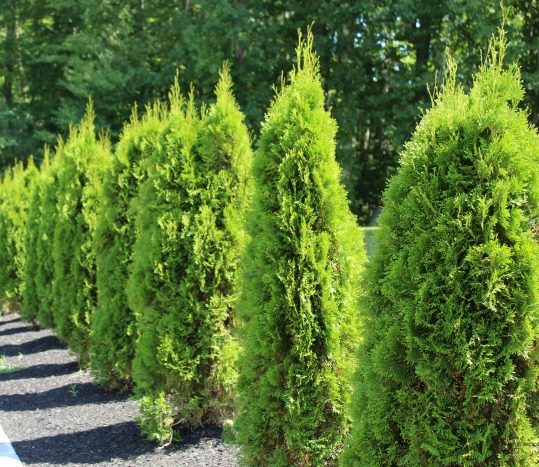Protecting evergreen shrubs and trees from the winter doesn’t have to be hard. Follow these simple steps to prevent winter burn.
As the snow starts to melt and you assess your landscape in early spring, it can sometimes be shocking.
What happened that made your evergreens turn brown? Are they completely dead or can they be nursed back to health?
Even more confusing is the winter may not have even been a harsh one. So what happened that caused so much damage to your evergreen shrubs and trees?
The culprit is most likely winter burn.
What Causes Winter Burn?
Winter damage, (or winter burn) occurs when evergreens don’t have enough stored water. On sunny days transpiration occurs in the leaves, moving water out of the plant. The root system however may be in a period of dormancy so it can’t take in any additional water to move through the plant. Instead the plant will rely on stored water and if there isn’t any the plant will begin to die. Winter Burn is most significant when 4 specific winter conditions occur simultaneously:
1. Sunny Days- When the sun is out during the winter months, evergreen foliage transpires (naturally loses water through their leaves). This means your plants are losing moisture.
2. Lack of Snow- You would think that less snow is a good thing. But in fact, snow has many benefits for plants. It acts as a natural insulator and protects roots from extreme cold temperatures. Snow also provides moisture to roots, so during the sunny winter days the melting snow irrigates the plants.
3. Cold Temperatures- Very cold temperatures, matched with a lack of snow cover means roots can freeze. A frozen root system is unable to drink. This means the plant can’t replenish the water lost during transpiration.
4. Wind- Intense winds also contribute to drying out evergreen shrubs and trees. Especially plants that are more exposed and have no natural or man made windbreak.
As defeating as this can be luckily there is a bright side. There are things you can do to protect your evergreens from winter damage.
How to Prevent Winter Burn
Fall Watering
It might seem a little unnatural watering your evergreens during the fall, especially if you haven’t been watering during the summer months. But watering evergreens in the fall is the best way to prevent winter burn.
Fall watering allows plants to store their moisture to be used at a later time. When plants are losing water due to winter transpiration this supply of stored water will prevent drying out.
Mulch Protects
Mulching garden beds is usually considered a spring chore for aesthetic reasons. But mulching has other benefits then just looking good.
Mulch helps insulate plant roots and is an added layer of protection from cold temps. Mulch also helps in retaining moisture which will help combat water loss due to winter transpiration.
Applying mulch as part of your fall gardening maintenance is one of the best things you can do to protect plants.
Buy Cold Hardy Plants
Plants that are not hardy to your planting zone will likely die during a harsh winter. Play it safe and buy plants that are well within the cold hardy limits to your region. Be sure to check the plant hardiness map to make sure you are up to date with the latest data.
Don’t Prune Evergreens in Fall
Pruning encourages new growth. That’s great during the spring and summer. But once fall hits evergreens need to store energy to get ready for winter dormancy. Pruning in fall can deplete valuable energy reserves and increase the likelihood of winter damage.
Wrap Shrubs and Trees
There’s no doubt that wrapping evergreen shrubs and trees is helpful for combating winter burn. But that doesn’t mean you have to wrap them in ugly burlap. Evergreens are the highlight of your winter landscape so don’t turn them into ugly brown potato sacs. If you strongly feel the need to wrap evergreens then consider using a better looking wrap.
Seasonal Needle Loss Is Normal
Don’t get confused in mid fall when you start to see some brown foliage on your evergreens.
Many homeowners get nervous and think their evergreens are already starting to feel the negative effects of cooler temps. But brown foliage during this time is actually very normal. This is called seasonal needle loss. This is the natural shedding process that evergreens go through every fall.
Check Out These Posts Next
Fall Gardening: Tips and Maintenance
Follow Me
Join my free email list!



Hi,
How often should I water? Ours is very brown and needles falling off tons. We had a hard freeze last winter and I think it caused damage. Now this winter is up and down in Texas, zone 8. I’ll be sick if we lose our one beautiful evergreen. Any advice is greatly appreciated. Take care!
Hi Susana, honestly it sounds more like a problem with the hardiness of the plant(meaning it’s not built for such temps) than it does winter burn. I’m curious to know what kind of evergreen it is. Chances are it might struggle with the random freezes Texas has been getting, especially last year. You might have to wait and see what happens as the weather begins to warm up and plants start waking up again. You can water now but only if the ground is not frozen and it is consistently warm, otherwise you could do more harm than good. I try to encourage fall watering instead of winter so the plant can store water and nutrients but at this point your shrub might be in a near dormant state where it probably won’t take up much moisture. Lastly, if you do find your evergreen isn’t very hardy for your region you can consider wrapping the plant in the winter. Also make sure you have bark mulch around the base of the plant at least 3″ thick.
That’s all good stuff but I live in Nebraska and what is considered enough watering and what is considered to much?
Dave
Hi Dave. I wouldn’t overthink it. I would do one deep soaking a week where you leave the hose on a slow stream over the base of the tree. You want to get the water deep into the root system, even beyond it a bit. This will go a long way heading into winter compared to doing nothing.
Should I use leaves to mulch 4 first year hydrangeas (that grew/performed beautifully this past spring and summer)? I live in Zone 5B — Colorado. My hydrangeas are planted next to a 6 foot fence; they will be in mostly shade throughout the winter because of the Sun’s angle. Snow will not readily melt in this area, either. Any tips on keeping these young hydrangeas safe through the winter?
Hi Tamara! I would rest easy if they are in the ground. You will have the additional cover from the fence, and then most likely snow. Just make sure you water them this fall. You could mulch with leaves but personally I prefer just using bark mulch. Using leaves could cause fungus problems and I usually like to keep leaves and debris clear of my plants.
Hi Mark!
I recently purchased and planted 4 green giant arborvitae late this August in zone 6 (north east PA).
One of the 4 (the largest of the 4) has an extreme amount of the brown seed pods you sometimes see on evergreens. The others have none. What does this mean for my tree? The seeds are not drying out and falling off- which I expected.
Hi Carol! It’s common for newly planted Arbs to produce seeds especially if they are stressed. It definitely sounds like for whatever reason this plant is the most stressed. Maybe lack of water, maybe it had a rough transplant with a lot of root damage, etc. It’s pretty amazing actually, the plant thinks it might die so it focuses it’s energy on producing seeds so other plants can take it’s place. The good news is it doesn’t necessarily mean it’s going to die, it just means its stressed. I would water it a lot especially heading into winter. You might be surprised how it bounces back in the spring. I’ve had a lot of newly planted Arbs do this and theyve usually been fine.